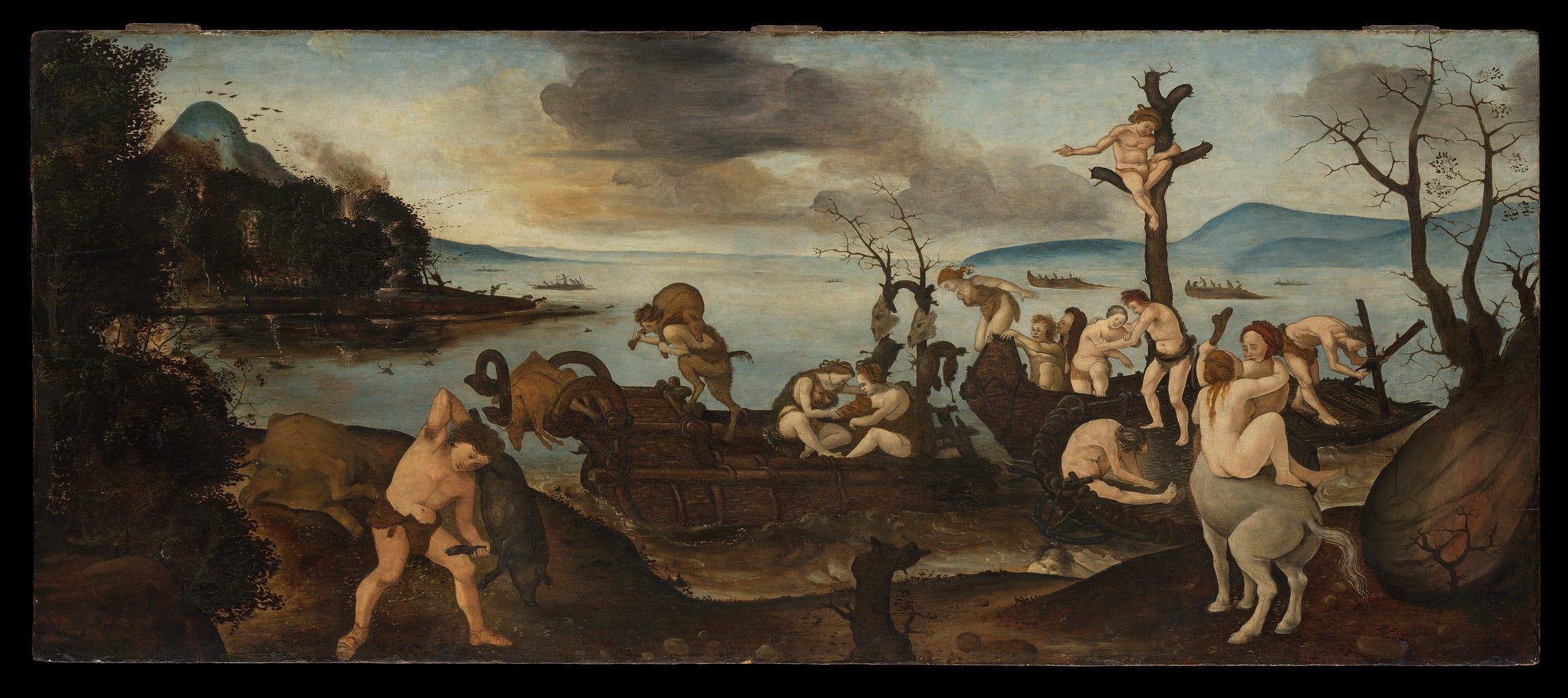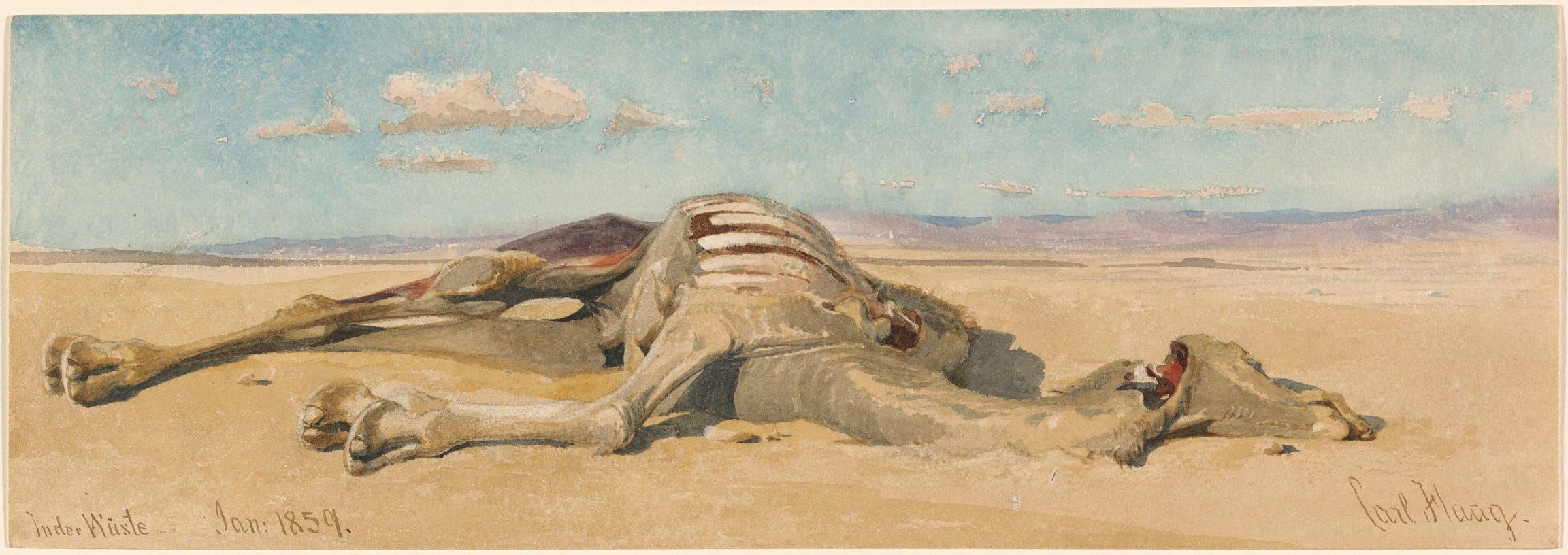The Liquidation of History in the Age of Trump and DOGE
Napoleon’s Burden, Mad Max’s Wasteland, and the Rule of Algorithms

“This is going to be great television.¹”
This was Trump’s parting remark as he dismissed reporters from the Oval Office after publicly humiliating the President of Ukraine this past Friday. We all witnessed this spectacle: Vice President Vance initiated the rebuke, followed by President Trump, as they criticized Zelenskyy for contextualizing his arguments historically. The Wall Street Journal observed that after about 50 minutes, Trump simply declared, ‘I think we’ve seen enough,’ signaling to his staff, and the world, that the performance had concluded.
This spectacle of immediacy stands in stark contrast to history’s burden. Napoleon Bonaparte failed because history weighed on him. Despite his grand ambitions, he remained tethered to the structures of history, seeing himself in the lineage of Caesar and Alexander. History was both his guide and his undoing. Trump, by contrast, operates in a world of pure immediacy, where power is not legitimized through historical continuity but through dominance in the present.
History, as Paul Valéry notes², is not an impartial force but a sum of events and conditions filtered through selection, classification, and preservation. It is determined as much by accident and habit as by explicit analysis.
Trumpism renders history weightless, and this transformation resembles the world of Mad Max, where the collapse of structured civilization gives way to a new kind of rule. A kind of world where speed, force, and spectacle define power rather than institutions or tradition. Trumpism 2.0 confirms we are in the midst of a larger shift from a world that once moved through striated structures to one increasingly defined by the smooth, frictionless logic of raw immediacy. This is precisely the unmediated environment Napoleon needed but never accessed.
What happens when power reconstitutes itself without the mediation of history?

Deleuze and Guattari, in A Thousand Plateaus³, outline a model of space that distinguishes between striated space, a structured, hierarchical space governed by rules and institutions, and smooth space, where order dissolves into fluid, decentralized movement (Deleuze & Guattari, 1987, pp. 474–500). Striated space is the world of bureaucracy, law, and governance, while smooth space is the realm of deterritorialization, where power operates through force and immediacy rather than institutions. Societies, they argue, oscillate between these states: structured regimes collapse, giving way to anarchic zones of raw survival, which then, over time, reconstitute into new hierarchies.
They introduce an important distinction that serves us well here: at any given time, one state may be subtending the other. The smooth state may be dissolving the striated state, or the striated state may be emerging from the smooth state. The two are not always in strict succession but can exist in tension, with one eroding or reconstructing the other.
This model plays out vividly in the Mad Max films.
From Law to Lawlessness: The Mad Max Cycle
In Mad Max (1979), civilization still exists but is unraveling. Max, a police officer who represents history, morality, and the remnants of a structured order, attempts to maintain law in a world dissolving into chaos. He helps arrest lawless nomadic criminals, but they are quickly set free by lawyers who no longer serve justice as an institution but instead act as agents of the dissolution of the previous historical order. This sets up a dynamic in which the legal system, once a pillar of striated space, has been co-opted by the logics of smooth space, where pure haptic immediacy overrides long-term vision and structured governance.
There is a pivotal scene where Max and his partner, Jim Goose, arrest a gang member, Johnny the Boy, for heinous crimes and bring him back to the police station. When they attempt to hold him accountable, government lawyers intervene, citing a flimsy technicality to justify his release. This enrages both Max and Goose, exposing the legal system’s impotence and its complicity in the breakdown of order. The frustration and disillusionment that follow set off a chain of events culminating in Max’s transformation into Mad Max, a man who abandons the failed structures of civilization in favor of survival in a lawless world, which informs the series of sequels.
This scene is eerily parallel to the recent Oval Office encounter between President Zelenskyy and President Trump. Zelenskyy invoked historical and legal arguments to challenge Russia’s actions, emphasizing past violations and the necessity of U.S. security guarantees. However, Trump and Vance dismissed these appeals, focusing on immediate political considerations and accusing Zelenskyy of jeopardizing global stability. The meeting concluded with Zelenskyy being asked to leave the White House, his references to law and history overshadowed by the administration’s emphasis on immediate power dynamics over established precedents.
In both cases — the fictional police station in Mad Max and the actual Oval Office — we see smooth space dissolving the striated, historically bounded space in real time. Those who still operate within the old order, Goose in the police station, Zelenskyy in the Oval Office, are humiliated or cast aside, their belief in structure making them vulnerable in a world that now moves through pure immediacy. The question that follows is the same: what happens when those who upheld the system awaken to its collapse?
Well, we know what happens in the future Mad Max movies. In Mad Max 2: The Road Warrior (1981), society has collapsed entirely into smooth space. Power is dictated solely by mobility, resource control (gasoline), and brute force. There are no governing structures, only shifting alliances and survival strategies. Most of the film operates on a plane of pure immanence, in Deleuze and Guattari’s parlance.
It is in Mad Max Beyond Thunderdome (1985) that we witness the first signs of reterritorialization. Bartertown emerges as a nascent society, complete with labor divisions (the pig-fueled underworld), economic exchange (the middle marketplace), and a political hierarchy (Auntie Entity presides from above, framed by cultural signifiers of pre-collapse civilization, as evidenced by the saxophone player accompanying her entrance when Max is brought to meet her). Governance is reinstated, albeit through violent means. But the oscillation is now shifting back toward the striated sphere, and hierarchical society is reterritorializing.
The two most recent Mad Max films, Mad Max: Fury Road (2015) and Furiosa: A Mad Max Saga (2024), continue this theme, though in an even more spectacular fashion. As they say, art imitates life.
What we should take away from this is that Trump and Trumpism, as a form, are in the process of deterritorialization (destruction). Trumpism operates in the mode of pure immediacy, with a clear goal: the dissolution of centuries of historically striated weaving that has structured the global order.
The warp and woof of the liberal world system, set in motion by the chants of Liberté, Égalité, Fraternité, that Napoleon sought to carry forward, are now being unraveled. But what happens when a world once woven with structure loses its warp? What new form does a woof take when it is no longer bound to an ordered foundation?
We can look to DOGE and its vision of algorithmic governance to see the first strands of an answer.

DOGE’s Algorithmic War Machine: Governance as Capital Flow
At first glance, DOGE’s reckless dismantling of government institutions appears irrational — chaotic destruction with no coherent vision and no regard for human life. And in many ways, it is. But viewed through Deleuze and Guattari’s framework, this violence signals something deeper and much more sinister: a fundamental shift from logos to nomos, from the striated space of institutional governance to the smooth space of algorithmic flows.
Nomos follows its own logic — the logic of the nomad, where power is not fixed but mobile, not deliberative but immediate. DOGE embodies this transition by accelerating what Deleuze and Guattari call ‘machinic enslavement,’ a system where power no longer relies on traditional labor exploitation but on the circulation of capital itself. As they observe, ‘it is as though, at the outcome of the striation that capitalism was able to carry to an unequaled point of perfection, circulating capital necessarily recreated, reconstituted, a sort of smooth space in which the destiny of human beings is recast.³’
DOGE is not in the business of reforming governance. It is dissolving it into the smooth, frictionless flows of capital — released from the physical limits of temporally bounded human beings. This explains its apparent recklessness. The goal is not efficiency in the traditional sense but absolute speed — a world where profit is no longer extracted through labor but through the velocity of transactions themselves.
Governance, in this model, ceases to be a deliberative structure and instead becomes a transient node within an integrated global system of capital circulation — an appendage of an algorithmic logic that recognizes no constraint beyond acceleration. The real work of governance, once mediated by institutions, norms, and historical precedent, dissolves into nomos: an unmediated, purely affective landscape where decision-making emerges not from reasoned debate but from the immediate interplay of forces, much like the war machine that Deleuze and Guattari describe as operating outside the striated space of the state.
DOGE is laying the preconditions for a future where States no longer structure capital but are instead structured by its flows, reducing citizens to nothing more than conduits for this process.

Rule Without Memory, Governance Without Governance
Napoleon failed because he mistook history for a script he could write himself into. Paul Valéry, in his introduction to The Outlook for Intelligence, captures this precisely when he observes that Napoleon ‘lost himself among the perspectives of the past and the mirages of dead grandeur.²’ Napoleon believed he could manipulate historical forces while remaining bound by their logic — a contradiction that proved fatal.
Most modern leaders have operated within this same paradigm. They see themselves as actors in a partially written script, their power legitimized through historical continuity, or at least made legitimate through the mediating force of history. Even revolutionaries justify their breaks with the past through historical narratives of progress or return. But Trump and Trumpism operate outside this framework entirely. They do not seek to position themselves within history; they act as if history does not exist.
This is where DOGE becomes a crucial mechanism for understanding our present moment. The dismantling of government institutions is not merely about ‘efficiency’ but about replacing them with algorithmic governance — a system deterritorialized from history, detemporalized, and decontextualized. Algorithms do not remember; they do not interpret; they do not weigh precedent. They process inputs and outputs, recognizing patterns without meaning or context. This makes them both powerful and dangerous in this political configuration.
In algorithmic governance, people and histories become irrelevant. The logic driving this transformation is not one of governance in any traditional sense but of erasure — removing temporally bounded, empirically limited human beings in favor of the ontological primacy of capital flow. The velocity of transactions becomes the organizing principle. The system thrives on capturing and repurposing human affective anxieties, transforming them into further capital circulation.
The Napoleonic ethos, with its grand vision of empire, was ultimately limited by the incommensurable conflict between Napoleon’s ambitions and the historical arc of modernity. The algorithmic ethos faces no such constraint. It recognizes no limit beyond acceleration itself. And as governance is absorbed into this machinic order, the upper limit is no longer human but energetic — the capacity to sustain frictionless flows of capital, unmediated power, and continuous extraction.
What we witnessed in the Oval Office was a demonstration of governance no longer hemmed in by historical legitimation. The world Napoleon needed but could never access. Rule without memory, governance without governance, acceleration without direction — a liquidation of the past, leaving us in the wasteland, where only fuel, speed, and survival dictate the order of things, and affective anxieties churn without form or resolution.
Citations
¹ Linskey, A., & Andrews, N. (2025, February 28). How Trump’s polite meeting with Zelensky descended into acrimony. The Wall Street Journal.
² Valéry, P. (1989). The outlook for intelligence (D. Folliot & J. Mathews, Trans.). Princeton University Press. (Original work published 1935)
³ Deleuze, G., & Guattari, F. (1987). A thousand plateaus: Capitalism and schizophrenia (B. Massumi, Trans.). University of Minnesota Press. (Original work published 1980)



